Cannon operation
| Part of a series on |
| Cannon |
|---|
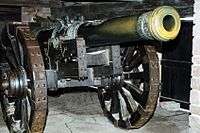 |
| History |
| Operation |
| By country |
| By type |
Cannon operation required specialised crew and gunners, who were first enlisted by the Spanish in the 14th century.[1] The nature of cannon operation often depended on the size of the cannon and whether they were breech-loading or muzzle-loading. English cannon of the late 14th century became mobile, while the largest cannon (such as the heavy siege cannon of the Ottoman Turks or the Jaivana cannon of India) required huge crews to transport and operate them.
As the "giant gun" trend disappeared in Europe, in favour of lighter, more manoeuvrable pieces in larger numbers, and cannon operating crews became smaller, heralding the early use of true field artillery. While the medieval Dardanelles Gun had required 200 men just to operate it, 18th-century English cannon required only a dozen men, including two gunners, while during the Napoleonic Wars five gunners were used.[2]
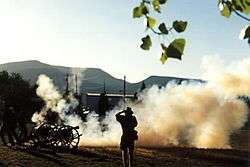
Overview
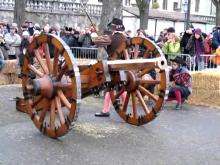
Cannon operation is described by the 1771 Encyclopædia Britannica. Each cannon would be manned by two gunners, six soldiers, and four officers of the artillery. The right gunner was to prime the piece and load it with powder, while the left gunner would fetch the powder from the magazine and keep ready to fire the cannon at the officer's command. Three soldiers stood on each side of the cannon, to ram and sponge the cannon, and hold the ladle. The second soldier on the left was charged with providing 50 rounds.[3]
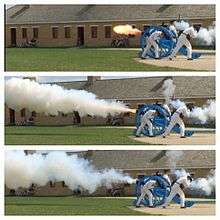
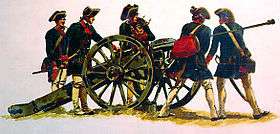
Prior to loading, the cannon would be well cleaned with a sponge to remove all sparks, filth, and dirt. The powder was added, followed by a wad of paper or hay, and the ball was thrown in. After ramming, the cannon would be aimed with the elevation set using a quadrant and a plummet. At 45 degrees the ball had the utmost range – about ten times the gun's level range. Any angle above the horizontal line was called random-shot. The officer of artillery had to ensure the cannon was diligently served. Water was available to dip the sponges in and cool the pieces every ten or twelve rounds.[3]
In the late 1770s it was said that a 24-pounder could fire 90 to 100 shots a day in Summer, or 60 to 75 in Winter. However, French artillery officers managed to have a cannon fire 150 shots daily during siege.[3] A 16 or 12 pounder would fire a little more, because they were more easily served. The Encyclopædia Britannica mentions "some occasions where 200 shots have been fired from these pieces in the space of nine hours, and 138 in the space of five."[3]
Projectiles fired from cannon
 Essential parts of a cannon:
Essential parts of a cannon:
1. the projectile or cannonball (shot)
2. gunpowder
3. touch hole (or vent) in which the fuse or other ignition device is inserted
Cannon instruments
Several instruments are used to service a medieval style cannon, as noted in the 1771 Encyclopædia Britannica.[3]
- The sponge is a long staff or rammer with a piece of fleece sheep or lambskin wound about its end, to serve for scouring the cannon when discharged, before it is to be charged with fresh powder. This cleaning prevents any spark or fire from remaining in the piece, which would endanger the life of the loading crew. Sponges were the most commonly used cannon cleaning instruments.[3]
- A wad-screw is two points of iron in the shape of a corkscrew, to extract the wad out of the piece. Used when the cannon has to be unloaded or dirt must be removed.[3]
- The lantern or ladle serves to carry the powder into the piece. It consists of a wooden box appropriated to the caliber of the piece for which it is intended with a length of a caliber and a half with its vent, and of a piece of copper nailed to the box at the height of a half caliber. This lantern must have three calibers and a half in length, and two calibers in breadth, being rounded on the end to load the ordinary pieces.[3]
- The primer must contain a pound of powder at least, and is used to prime the pieces.[3]
- A rammer is a round piece of wood, commonly called a box, which serves to drive home the powder and ball to the breech. It is fastened to a stick twelve feet long, for the pieces from twelve to thirty-three pounders, and ten for the eight and four pounders.[3]
- The botefeux is used to hold a winding of match with which to fire the cannon. May be a stick two or three feet long with a split to hold one end of the match.[3]
- A priming iron is a pointed iron rod, used to clear the touch hole of the pieces of powder or dirt. Also used to pierce the cartridge, that it may sooner take fire.[3]
- The quoin of mire are pieces of wood with a notch on the side to put the fingers on, to draw them back or push them forward, when the gunner points his pieces. They are placed on the sole of the carriage.[3]
Leaden plates are used to cover the touch-hole, when the piece is charged, to keep dirt from entering the touch-hole.
History
Pre-Renaissance cannon
In 1248, Roger Bacon's "Opus Maior" described a gunpowder recipe and recognised its military use:
We can, with saltpeter and other substances, compose artificially a fire that can be launched over long distances... By only using a very small quantity of this material much light can be created accompanied by a horrible fracas. It is possible with it to destroy a town or an army ... In order to produce this artificial lightning and thunder it is necessary to take saltpeter, sulfur, and Luru Vopo Vir Can Utriet.
In Spain, the specialised nature of cannon operation was first recognised, and the Spanish kings at the initial stages enlisted the help of Moorish experts:
- "The first artillery-masters on the Peninsula probably were Moors in Christian service. The king of Navarre had a Moor in his service in 1367 as maestro de las guarniciones de artilleria. The Morisques of Tudela at that time had fame for their capacity in reparaciones de artilleria."[1]
Certainly cannon were used at the Battle of Crécy, but how they were deployed, or how many crew were assigned, is unclear.[4] It is known that in the 1380s, however, the "ribaudekin" clearly became mounted on wheels, offering greater mobility for its operation.[5] Wheeled gun carriages became more commonplace by the end of the 15th century, and cannon were more often cast in bronze, rather than banding iron sections together.[6] There were still the logistical problems both of transporting and of operating the cannon, and as many three dozen horses and oxen may have been required to move some of the great guns of the period.[6] Each had its crew of gunner, matrosses and drivers, and a group of "pioneers" were assigned to level to path ahead.[6] Even then, the gunpowder mixture used was unstable and could easily separate out into sulfur, saltpetre and charcoal during transport.[6]
Once on site, they would be fired at ground level behind a hinged timber shutter, to provide some protection to the artillery crew.[6] When the Ottoman Turks used stationary "falcons" at the 1422 Siege of Constantinople, for example, they had to build barricades "in order to receive… the stones of the bombards."[7] Timber wedges were used to control the barrel's elevation.[6] The majority of medieval cannon were breechloaders, although there was still no effort to standardise calibres.[6]
Larger cannon were used in greater numbers during the Fall of Constantinople: Sultan Mehmet II used 68 Hungarian-made cannons, the largest of which was 26 feet long and weighed 20 tons; this fired a 1,200 pound stone cannonball, and required an operating crew of 200 men,[8] as well as 70 oxen and 10,000 men just to transport them.[7] For the defenders, the Walls of Constantinople could not be adapted for the operation of artillery, and towers were not good gun emplacements. There was even worry that the largest Byzantine cannon could cause more damage to their own walls than the Turkish cannon.[7] The changing needs of cannon operation thus led to the development of trace italienne of Italy and the Tudors' Device Forts in England, using specially built cannon batteries to their greatest effect.
Renaissance to early 19th century

While "coal and sulfur" had been recognised as the best weapon for naval warfare as early as 1260,[9] cannon saw their first real naval use in large numbers during the Renaissance. The French "culverin", adapted for naval use by the English in the late 16th century, was of relatively long barrel and light construction, and fired solid round shot projectiles at long ranges along a flat trajectory. The Tudor carrack the Mary Rose was equipped with 78 guns (91 after an upgrade in the 1530s), and was one of the first ships to have the theoretic ability to fire a full cannon broadside.[10]
Its Scottish counterpart, the Great Michael, mounted 36 great guns and 300 lighter guns, with 120 gunners.[11] The former included Mons Meg, making her the warship with the largest-caliber gun in history.
In Niccolò Machiavelli's The Art of War, the Italian Renaissance writer observed that "small pieces of cannon… do more damage than heavy artillery. The best remedy against the latter is making a resolute attack upon it as soon as possible…"[12][13] As was the case at Flodden in 1513, the Scottish siege artillery could only fire one round a minute, while the English field guns could fire twice or even thrice as many.[14] Guns also had to be moved back into position after recoil, and the speed of this would reflect the gunners' experience.[14]
A description of the Gunner's techniques is given during the English Civil War period (mid-17th century) by John Roberts, covering the modes of calculation and the ordnance pieces themselves, in his work The Compleat Cannoniere, printed London 1652 by W. Wilson and sold by George Hurlock (Thames Street). In the 17th century, large wheels were typical of field guns, as opposed to the lighter carriages used for fortress and naval cannon.[15] At coastal fortifications, furnaces would be used for heating red-hot shot to be used against ships.[15] The lower tier of English ships of the line at this time were usually equipped with demi-cannon — a naval gun which fired a 32-pound solid shot. A full cannon fired a 42-pound shot, but these were discontinued by the 18th century as they were seen as too unwieldy.

The introduction of carronades at the end of the 18th century also resulted in guns that were easier to handle and required less than half the gunpowder of long guns, allowing fewer men to crew them than long guns mounted on naval garrison carriages.[16]
During the Napoleonic Wars, a British gun team consisted of 5 numbered gunners - fewer crew than needed in the previous century. The No.1 was the gun commander, and a sergeant, who aimed the gun. The No.2 was the "spongeman" who cleaned the bore with the sponge dampened with water between shots; the intention being to quench any remaining embers before a fresh charge was introduced. The No.3, the loader, inserted the bag of powder and then the projectile. The No.2 then used a rammer, or the sponge reversed, to drive it in. At the same time, the No.4 ("ventsman") pressed his thumb on the vent hole to prevent a draught that might fan a flame. The charge loaded, the No.4 pricked the bagged charge through the vent hole and filled the vent with powder. At the No.1's command the No.5 would fire the piece with his slowmatch.[2]
Notes
- 1 2 Hoffmeyer, p. 217.
- 1 2 Holmes, Redcoat British Soldier in the age of Horse and Musket
- 1 2 3 4 5 6 7 8 9 10 11 12 13 "Gunnery". Encyclopædia Britannica. London. 1771.
- ↑ Asquith, Crécy 1346: Triumph of the longbow, p 89
- ↑ Nicolle, Crécy 1346: Triumph of the longbow, p 21
- 1 2 3 4 5 6 7 Sadler, p 22-23
- 1 2 3 Turnbull, The Walls of Constantinople, AD 324–1453
- ↑ Military and War Weapons: the Cannon
- ↑ King's Mirror, Chapter XXXVII: The duties, activities and amusements of the Royal Guardsmen, from the Konungs skuggsjá.
- ↑ Mary Rose Official Site
- ↑ Sadler, p. 15
- ↑ Niccolò Machiavelli, The Art of War, p.97
- ↑ Sadler, p. 61
- 1 2 Sadler, p. 60
- 1 2 See Griffith, p. 43
- ↑ The Historical Maritime Society Archived May 16, 2008, at the Wayback Machine.
References
 This article incorporates text from the 1771 Encyclopædia Britannica, which is in the public domain.
This article incorporates text from the 1771 Encyclopædia Britannica, which is in the public domain.- Griffith, Paddy; Dennis, Peter. The Vauban fortifications of France. Oxford: Osprey, 2006 (paperback, ISBN 1-84176-875-8).
- Hoffmeyer, Ada Bruhn de. Arms and Amour in Spain.
- Holmes, Richard. Redcoat British Soldier in the age of Horse and Musket.
- Nicolle, David (2000). Crécy 1346: Triumph of the longbow. Osprey Publishing. ISBN 978-1-85532-966-9.
- Turnbull, Stephen (2004). The Walls of Constantinople AD 324–1453 (Fortress 25). Osprey Publishing. ISBN 1-84176-759-X.
- Sadler, John (2006). Flodden 1513: Scotland's greatest defeat (Campaign 168). Osprey Publishing. ISBN 978-1-84176-959-2.